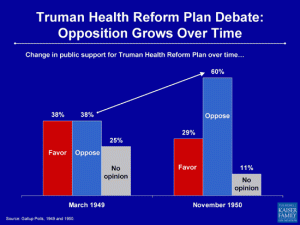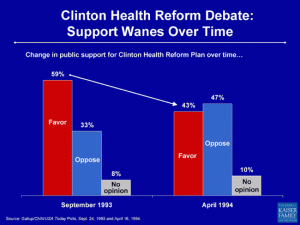Window of Opportunity?
Beginning this Spring, between expected approval of an economic stimulus package and the start of campaigning for the midterm election, there will be a rare window of opportunity for passage of major health reform legislation. History suggests that momentum can be lost if policymakers do not move quickly to seize these rare openings when they occur. There is an opportunity now because the nation has a popular new president with political capital to burn who is making health reform a priority. Democratic leaders in control in the Congress want to deliver on health care. And a historic recession has transformed health care into a bread and butter economic issue of real salience to working people and the middle class, who are worried about paying their health care bills and about losing their jobs and their families’ health coverage. Many years ago a great political scientist named Aaron Wildavsky wrote an article called “The Two Presidencies” in which he contrasted the relative power of the presidency in foreign policy with its comparative impotence in domestic affairs. But Wildavsky argued that times of crisis such as the economic meltdown the country faces today present exceptions to the rule. There remain serious obstacles to passing major health legislation, not least the challenges of reaching across the aisle and forging consensus on key elements of reform and the very real problem of finding a way to pay for expanding coverage in the current budgetary environment. However, the kind of opportunity the president and Congress have now in health does not come along often.
These two charts, dating from as far back as the Truman era and as recently as the Clinton one, underscore the argument for moving as quickly as possible to take advantage of moments of opportunity before opposition to health reform legislation emerges and public enthusiasm wanes. They show how opposition to the Truman plan rose and support for the Clinton plan fell when debate shifted from consensus about initial goals to disagreement about details. It’s inevitable in a drawn out legislative process that media and public attention will shift to the tradeoffs involved in health reform and the difficult business of controlling costs and paying for expanding coverage. A new poll we will release next week will show both the opportunity for action now, but also the potential for a similar unraveling of support in the face of some of the arguments likely to be made by opponents in the face of a protracted debate about the issues and tradeoffs in health reform. Familiar constants in public opinion always lurk just beneath the surface as well. For example, people do not want to pay more out of pocket as a result of any health reform plan — in fact, they’re looking to pay less — and they don’t want to be forced to change their current health care or health insurance arrangements. As in the past, these and other fears can be exploited by opponents of legislation in an extended debate, whether or not they are actually true. Maintaining support through a lengthy national debate may be even more difficult in the modern era where public opinion can be influenced by interest groups waging ad wars on TV, or now on YouTube, much like in political campaigns. (Click on a chart to enlarge)
Right now, we’re mostly in the “happy talk” phase of the health reform debate. All of the major interest groups are in favor of reform of some sort, and the public is supportive of major action. But there are many elements of the plans that have been proposed that could spark opposition – for example, requirements on employers and individuals, a new institute or federal agency with a mandate to conduct research on the comparative effectiveness of treatments, new regulations affecting the health insurance industry, and of course how to finance coverage expansions over the long term. In fact, the notion of creating a public plan like Medicare to compete with private insurance plans has become an early target of the insurance industry. CBO scoring will add to the challenge because in general the measures that will be credited with producing the largest short term savings which political leaders will need to pay for their plans will be the most politically controversial.
While efforts are already being made to rally the public as a counterweight to likely opposition to legislation — something that didn’t happen in a coordinated way during the debate over the Clinton plan — history suggests that delay and a long public debate can be the enemy of health reform legislation. That may be more true than ever now, when our economic circumstances appear to have created a unique willingness to invest in health care in the short term as part of an effort to stimulate the economy and address the public’s economic insecurities, with the promise of savings as a result of reform over the long term.
Quick action may offend those who think that it’s the job of Congress to get things exactly right when legislation is first drafted, or that a long debate and a full vetting is the right way for a democracy to deal with a big issue like health reform. But more than any other single factor it’s the recession that makes the environment for this health reform debate different from the last one, and a reading of history suggests that if action rather than another health reform stalemate is to be the outcome, one strategy may be to move fast and seize legislative opportunities when they present themselves, get at least the basics right, and fix whatever problems emerge later on.


